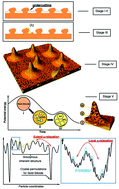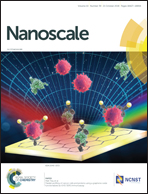Evolution of 3D nanoporosity and morphology in selectively dealloying ternary Au55Cu25Si20 metallic glass ribbon with enhanced alcohol electro-oxidation performance†
Abstract
Current fabrication methods of nanoporous gold (NPG) mainly rely on dealloying Ag–Au binary crystalline precursors, typically Ag65Au35, with the “dealloying threshold” or “parting limit” above 55 at%. Here we report a simple chemical dealloying process, through selective dissolution of one element from a Au55Cu25Si20 metallic glass ribbon with low ‘parting limit’, and a novel peculiar three-dimensional ‘cone shaped protrusion’ nanoporous structure which has never been reported before. In this structure, a metastable gold silicide formed in the initial dealloying stage was decomposed into gold nanoparticles and amorphous SiOx in the later coarsening stage. Our finding provides insights into the underlying relationship between ‘parting limit’ and atomic level structure of metallic glass. Comprehensive discussions on the porosity evolution stages as well as the correlation between the porous ‘cone shaped protrusion’ development and potential energy landscape are made in this report. The fabricated 3D NPG also exhibited excellent electro-oxidation catalytic ability attributed to the high density of low-coordinated atomic sites provided by the gold particle inside of ‘cone shaped protrusion’.



 Please wait while we load your content...
Please wait while we load your content...